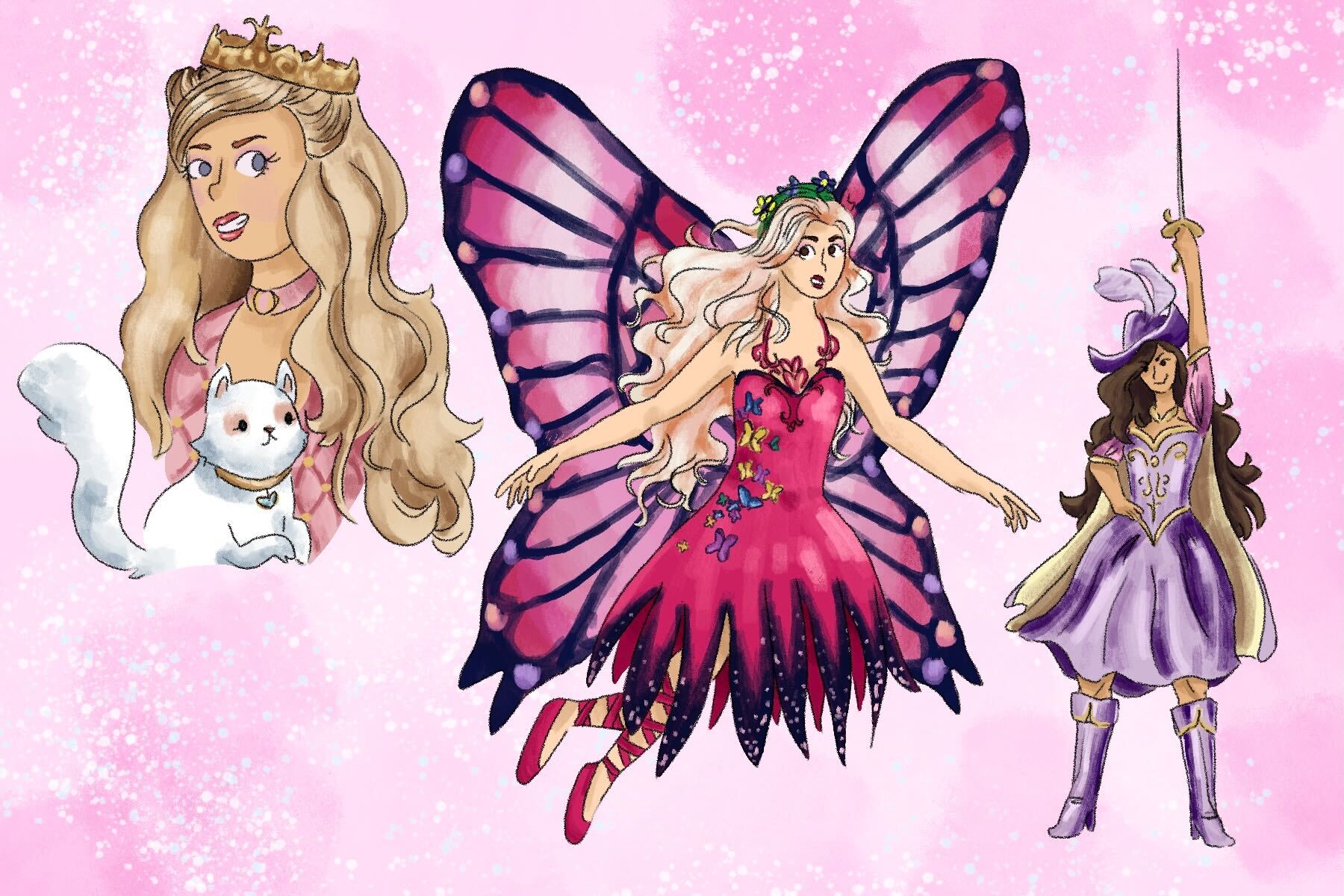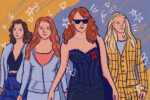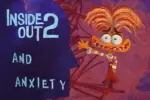Unless you’ve found a very large rock to reside under, you’ve probably seen or at least heard of plenty of Marvel movies. Altogether, blockbuster hits like “Black Panther” and “Avengers: Endgame,” as well as a growing number of TV spin-offs, comprise the ambitious Marvel Cinematic Universe, or MCU for short. However, the Disney-owned superhero franchise is not the only iconic cinematic universe delighting fans today.
With all the uncertainty of unprecedented times, many people have enjoyed looking back at the content that defined the simpler times of their childhood. It’s part of why fashion has also seen a recent rise in “Y2K” aesthetics. For those who grew up in the 2000s, Barbie is one of those comforting, nostalgic, plastic faces that dominated the new millennium. Whether the iconic doll and character was moonlighting as Rapunzel or The Swan Princess, the Barbie Cinematic Universe brought joy to lots of 2000s and late ‘90s kids. Although these kids are grown up now, they’re still ready to rediscover the pink-washed fantasies of their youth one meme at a time.
marvel cinematic universe? i only know the barbie cinematic universe pic.twitter.com/GmkpNKX2KD
— RINA. (@LAVIDAPRADA) May 25, 2021
Barbie’s History
Entrepreneur Ruth Handler created Barbie in 1959, finding inspiration from watching her daughter play with paper dolls that she projected her own hopes and dreams onto. Handler saw a gap in the doll market, which created dolls to make girls feel like caretakers, as opposed to dolls that reflected young girls’ professional and personal aspirations. According to Mattel’s Barbie media site, “Ruth’s philosophy behind Barbie was that through the doll a little girl could be anything she wanted to be and that she has choices. Over the brand’s 60 years, Barbie has empowered girls to imagine themselves in aspirational roles from a princess to president.”
Although Barbie and her brand has had to go through lots of updates to stay relevant and empowering, her purpose has more or less stayed the same for decades. Through Barbie, young children — especially young girls — are meant to see the wide variety of lives they could lead. While less focused on occupation, the Barbie Cinematic Universe provided an easy way to portray Barbie in multiple roles.
Barbie’s official onscreen debut was the 1987 TV movie “Barbie and the Rockers: Out of This World,” where “rock sensation Barbie and her band The Rockers, beloved by everyone all around the world, decide to do something no band has ever done before — perform a charity rock concert in outer space.” This movie was followed by a sequel the same year, wherein Barbie and her intergalactic rock squad come back to Earth to find themselves thrown into the sockhopping ‘50s. But as revolutionary as those plots may seem, both movies clock in at barely over 20 minutes, making these two appearances a mere warm-up for Barbie’s real film revolution.
“Barbie in the Nutcracker” and CGI
The turning point for the Barbie Cinematic Universe came in 2001, just after the start of the millennium, when “Barbie in the Nutcracker” premiered. Barbie became a pioneer of the 2000s Digital Revolution when creators began using CGI animation to showcase her adventures. You can’t watch a Marvel movie today without it, but Barbie was on the frontlines of CGI when it was still groundbreaking, new technology. The movie adapts “The Nutcracker” ballet (itself adapted from E.T.A. Hoffmann’s story “The Nutcracker and the Mouse King”), and it was probably many kids’ first exposure to the sounds of famous composer Tchaikovsky. Now, there’s a whole generation that might hear haunting classical music and envision Barbie’s smiling face as she meets the Gingerbread villagers or crosses the Sea of Storm.
The movie doesn’t just steal the dance’s plot, however; it also heavily features ballet. Peter Martins choreographed the dance scenes, and according to the movie’s wiki page, “The New York City ballet company helped bring the dancing in the film to life through motion capture which was the first animated film to use that technology.” The movie, which follows Barbie as Clara trying to break the curse on her prince-turned-nutcracker and end the tyranny of the evil Mouse King, enchanted many. It won awards for its attention to detail (despite several goofs), and another trivia fact states, “One animator’s entire job was dedicated to getting the swish of Barbie’s hair just right in the animated ballet.”
Rivalry with Bratz
The films were genius as far as sales went. They created a perfect marketing campaign for new dolls parents could buy their children to match the ones they saw on TV. The movies sold in their own right, but they also acted as 80-minute advertisements for young, malleable audiences. After immersing themselves in a land of bright pink CGI sets, kids could recreate the experience by immersing themselves in endless pink plastic infrastructure sold by Mattel. That’s why Mattel wasn’t the only doll company to eagerly break into the cinematic market to up their sales.
Barbie’s main competition at the time was Bratz. YouTuber Kurtis Conner made a video comparing the two brands’ approach to film, noting the ridiculous case of Mattel suing Bratz to minimize competition, as well as the inherent controversy of the Bratz dolls. With their big eyes, big lips, makeup and fashionable clothes, the Bratz dolls were accused of being over-sexualized and giving the wrong idea to impressionable young girls who liked them. However, Bratz was always more inclusive of different skin tones, which offered more chances for kids to see themselves reflected than the white, blonde Barbie with her own problematic proportions. However, even if the Bratz Cinematic Universe is your pick, it too must pay homage to its predecessor, the Barbie Cinematic Universe, for setting the curve.
Barbie and the Memeification of the BCU
Although Barbie still churns out plenty of media and television today, nothing will ever quite surpass the Golden Age of Barbie audio-visual media in the 2000s. Following “Barbie in the Nutcracker,” this era saw earth-shaking, legendary animated cinema such as “Barbie as Rapunzel,” “Barbie of Swan Lake,” “Barbie as The Princess and the Pauper,” “Barbie: Fairytopia,” “Barbie and the Magic of Pegasus 3-D,” “Barbie Fairytopia: Mermaidia,” “Barbie Diaries,” “Barbie in the 12 Dancing Princesses,” “Barbie as the Island Princess” and “Barbie Mariposa and Her Butterfly Fairy Friends.”
In its heyday, Barbie was dropping at least two iconic films a year, which loyal fans could watch and rewatch on DVD or on the even more obsolete VHS. With the ease and non-hassle of modern-day streaming sites, it’s hard to imagine the joy of finding your movie for the night at the local Blockbuster store or prying open the large and chunky plastic VHS cases to pop in “Barbie in the Nutcracker” every year at Christmas.
And the internet, for all its flaws, is nothing if not good at connecting people through nostalgic childhood memories like these. Now, as many go back to rewatch their old favorites, they realize how ridiculous the movies they were so fond of really are. Whether through commentary YouTubers like Kurtis Conner or old fans making compilations, people are enjoying rewatching these classic movies in all their absurdity.
For instance, people still go wild for the crazy animal sidekicks, such as Mother Gothel’s creepy weasel accomplice in “Barbie as Rapunzel” or Bibble, a Barbie Cinematic Universe regular with his own fan-run Twitter account. The strange, brightly colored, fuzzy, flying creature accompanies Barbie in both her Fairytopia and Mermaidia adventures. YouTuber earthtocaitlin captured Bibble’s Barbie Cinematic Universe importance in the compilation “Bibble is the powerhouse of the cell.”
mentally i'm at the barbie cinematic universe pic.twitter.com/7LBuhVKoym
— DUDA (@saintdemie) October 26, 2021
YouTuber Alyssa CT made a slightly more comprehensive Barbie Cinematic Universe compilation called “i watched every barbie movie and took it out of context,” which captures the random, sometimes intentional, sometimes unintentional comedy of these movies. Commenters agree: “I swear the animations were so good as a kid”; “The fact that they managed to make all the movies with the same sh—y quality is just a talent”; and “The fact that I made my grandmother sit through these with me all those years ago makes me extremely guilty.”
Rose comments, “I love how the Barbie fanbase is just a bunch of memes and out of context scenes at this point. Truly beautiful,” and Tristan Alexander theorizes, “i feel like they purposefully made these movies good enough that we like them when we’re little but bad enough to make fun of when we’re older.” Whether you’re seeking to fondly reminisce on simpler days or laugh at the hilarity of what you once thought was “good,” or even to watch some of these movies for the first time, the Barbie Cinematic Universe is your place to look for comforting, brightly colored escapism and generational connection.

















